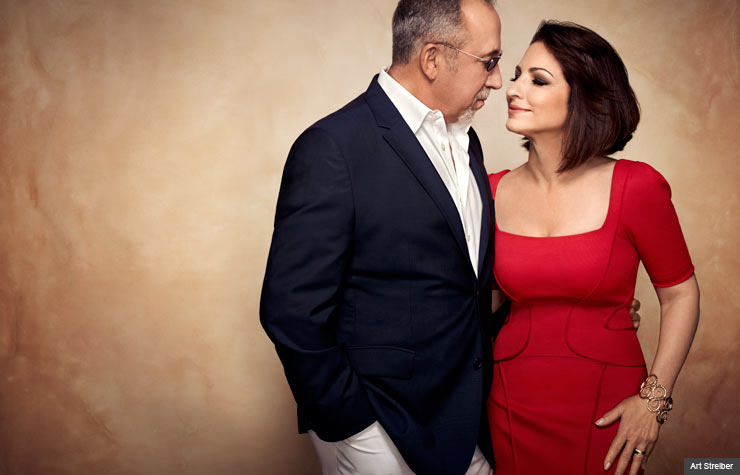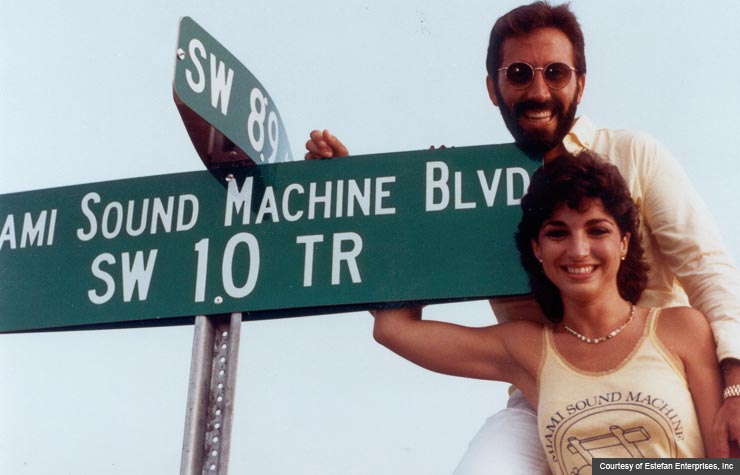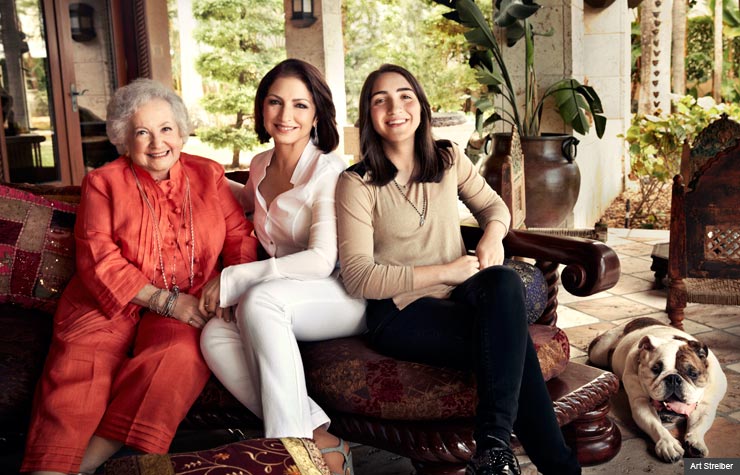Staying Fit


On the kind of glorious Miami day that puts picture postcards to shame, Gloria and Emilio Estefan, the city's most high-profile power couple, stand in the ornate, Moroccan-style entertainment room of their Star Island estate, posing for a photographer.
Playing in the background is The Standards, Gloria's new CD, a romantic, multilingual interpretation of the American songbook. The pair begin to sway, dancing in place. Suddenly, Emilio's hand, which a moment ago was wrapped around his wife's tiny waist, slips lower down her formfitting dress.


AARP Membership— $12 for your first year when you sign up for Automatic Renewal
Get instant access to members-only products and hundreds of discounts, a free second membership, and a subscription to AARP the Magazine.
"He's copping a feel!" Gloria exclaims in mock protest, her throaty tone instantly recognizable as the defining voice of the Miami music scene. (Don't miss the exclusive video, below, of AARP's visit to Gloria and Emiliio's home.)
In the mid-1980s, Gloria, now 56, and Emilio, 60, propelled themselves onto the national stage with their Latin crossover band, Miami Sound Machine, for which Gloria sang lead vocals and Emilio played keyboards. They cultivated a Cuban dance beat that sent songs "Conga" and "Rhythm Is Gonna Get You" to the top of the charts.
The Estefans' fusion of pop, disco and salsa sold 100 million albums and won Gloria seven Grammy awards. It also paved the way for the crossover explosion of Latin music, mostly through artists that Emilio (who has his own 19 Grammys) brought to the forefront, including Ricky Martin, Jennifer Lopez, Marc Anthony and Shakira.
It all made the Estefans — both Cuban immigrants who arrived in South Florida with next to nothing — rich beyond anyone's wildest imagination. Today their estimated net worth hovers around $700 million, not just from the entertainment business but also from commercial endorsements and shrewd real estate investments.
From Rags to Riches, Literally
Emilio and Gloria Estefan's story of personal and professional reinvention is so extraordinary, in fact, that this year they signed a deal to turn their lives into a Broadway musical.
"I'm so psyched!" Gloria enthuses, sitting in her writing den ("my lair"), where photographs crowd the walls. "There are so many story lines. It's a universal story, it's an immigrant story, and it's a love story. In the United States, if you believe in yourself and you're determined and persevere, you're going to succeed."
To be sure, the Estefans' gated mansion isn't just a testament to affluence. It's a house of love — for each other, for family and for the country the couple says allowed them to become all they are. Gloria insisted they wait to purchase the property until they had the cash in hand: "We've got that immigrant mentality. No mortgages."


"My success is not about money," explains Emilio, a gregarious man with an open smile. "But the real estate — as an immigrant, you always want to have a backup. Something happens to you, you don't want your kids to go through what you went through."
Emilio Estefan was 14 years old when he left Fidel Castro's Cuba. With his father, he flew to Spain, his mother's native country, to get a visa. A year later, in 1968, he relocated to Miami, where he, his dad and 15 cousins shared a cramped apartment. Skilled at playing several musical instruments, Emilio soon realized his talents could work in the family's favor.
"I saw a guy playing accordion in a local restaurant at night," he remembers. "I went in and said, 'Do you mind if I come for lunchtime? I play accordion, and you just give me food for me and my dad.' "
The job nourished body and soul. "Music took me away from the pain. It took me nine years to raise enough to bring my mom and older brother from Cuba to Miami. That was nine years apart from my family."
Emilio's Other Role
As Life Reimagined ambassador for AARP, Emilio Estefan shares his expertise on a variety of subjects, including entrepreneurship, mentoring, philanthropy and more.


Castro came to power in 1959, when Glorita, as Gloria was known, was 18 months old. Until that time, her parents — Gloria, a teacher, and José Manuel Fajardo, a police officer who rode in the motorcade of the wife of then Cuban President Fulgencio Batista — enjoyed an idyllic life in Havana.
Fajardo, his family says, was a political idealist: incorruptible and devoted to Batista. So, at the first opportunity after the revolution, he flew with his wife and Glorita to exile in Miami. He secretly joined a U.S.-backed effort to overthrow Castro — the infamous Bay of Pigs invasion of Cuba. Gloria Fajardo learned to make dinner from Spam, stood in line for government cheese and waited for news.
When Cuban armed forces defeated the invaders in 1961, José was jailed for almost two years before being released as part of an exchange between the U.S. and Cuba. His ordeal so affected his daughter that decades later it inspired political activism of her own.
In 1992, Gloria was part of a United Nations committee that produced the first human rights report on Cuba. And in 2010, she led a Miami march in support of a Cuban opposition movement.
"As an immigrant, I appreciate, far more than the average American, the liberties we have in this country," she says as she leads a guest into the kitchen for refreshments. "Silence is a big enemy of morality. I don't want our blunders in history to get repeated."
Gloria's impulse to right wrongs goes back to 1963, by which time her father had become an American citizen and an officer in the U.S. military stationed at Lackland Air Force Base in San Antonio. Gloria was in first grade there, trying to fit in despite not being fluent in English. After a fellow student called her stupid, she quickly mastered her second language, illustrating the drive that would define her.
"Six months later," she says, beaming, "I stole the reading award from him."
When her dad was deployed to Vietnam, Gloria and her mom returned to Miami, where young Gloria began to blossom as a singer. She'd send her father tapes, and José responded with the promise "You are going to be a star."
But soon her father would be diagnosed with multiple sclerosis. (The family believes his medical problems were caused by Agent Orange, the defoliant to which U.S. troops were exposed.) Gloria, barely a teen, was thrown into the role of caregiver while her mother worked and studied for a teaching credential.




































































More on entertainment
Raquel Welch at 70+
Proof that age doesn't diminish beauty